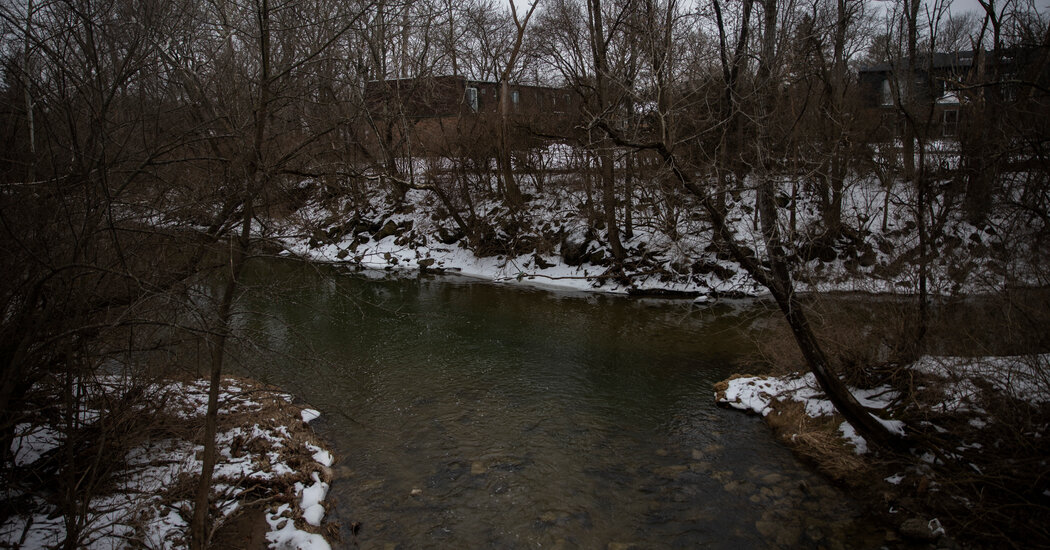Developers have recently realized the value of even the most minor waterways for commerce, but experts advise caution because of flooding risks.
Trotwood is a hard-luck suburb of Dayton, Ohio. With a population of about 25,000, it was once the region’s premier retail and entertainment destination. The city boasted one of the area’s first enclosed malls, numerous shopping plazas, big-box retailers and a 5,500-seat arena.
But changing demographics and economic shifts led the city into a steep decline. Today, it’s a retail wasteland of shuttered storefronts, and the arena has long been demolished. Even a Dollar General recently announced that it was closing.
But Trotwood has another asset to count on as it plots a comeback: Wolf Creek, a ribbon of water that meanders through the town to meet the Great Miami River in Dayton.
A former rail line along the creek has been converted into a bike path, and on warm spring days, cyclists pedal under the shade of sycamores. Still, Wolf Creek often goes unnoticed by those who live near it.
“Many residents cross it every day but don’t realize it’s there,” said Chad Downing, executive director of the Trotwood Community Improvement Corporation, which is leading the city’s redevelopment.
Like many small cities and towns across the country, Trotwood had turned its back on its creek, dismissing it as irrelevant and an occasional nuisance. But developers have recently realized the value of even the most minor waterways for luring customers and commerce.
For decades, urban renewal in large cities has centered on riverfronts, and smaller towns are now recognizing that creeks can provide the same opportunities. Officials in Mason City, Iowa, for example, have set their sights on redeveloping the area around Willow Creek, and the City Council in Meadville, Pa., recently commissioned a study to see how it could develop the area around French Creek. In Gahanna, Ohio, city leaders have been embracing Big Walnut Creek with a variety of mixed-use developments as part of a Creekside master plan.
But the creeks can also pose flooding risks, aggravated as climate change causes increasingly extreme weather events, making long-term development a spin of the roulette wheel. Rivers generally rise more slowly and keep areas submerged longer, but creeks, streams, and small rivers create different challenges. Streams of water that most of the year aren’t deep enough to reach an adult’s ankles can suddenly morph into torrents that can sweep away cars, rip homes from their foundations and leave a trail of destruction.
Climate change weighs on Mr. Downing as he helps plot Trotwood’s comeback. The city is trying to redevelop its downtown into a more dense, walkable environment that embraces the creek. One of the cornerstones will be a 20-acre parcel that borders Wolf Creek, which Mr. Downing envisions as a mixed-use development.
“But how do we make sure we are not creating a flood situation that has to be dealt with in the future?” he said.
Steep banks hem in Wolf Creek, and the water hasn’t breached them in recent memory, but that doesn’t mean it someday couldn’t. Mr. Downing is more aware that the decisions he makes now could resonate in his lifetime, he said, so Trotwood will embrace Wolf Creek in a creative yet cautious way.
Climate change will cause more frequent extreme events involving small waterways, said Seth Binau, science and operations director at the National Weather Service in Wilmington, Ohio. He explained that a warmer atmosphere is laden with moisture, which creates heavier amounts of water routed into streams that are easily overwhelmed.
Increased commercial development worsens the problem by creating impervious surfaces, which force more water into creeks, causing them to rise faster and farther.
Developers should steer clear of building anywhere in the 500-year flood plain of a creek, said Bill Becker, a climate change expert and former Department of Energy official who has worked with communities and developers to assess creek development risk.
The Federal Emergency Management Agency publishes maps outlining 100-year and 500-year flood levels, but Mr. Becker said even those maps did not go far enough. There is an inherent tension, he said, because people are drawn to water, and developers are likely to follow.
“And developers love the creek land because it is often low priced,” said Mr. Becker, author of “The Creeks Will Rise,” which details how people and streams can coexist.
And as communities turn toward their creeks for redevelopment, those assets come with a price because of the increased risk of extreme weather.
“Past isn’t prologue anymore,” Mr. Becker said, adding that just because a stream has not flooded beyond its banks does not mean that it will not happen one day.
In Lincoln, Neb., where Salt Creek meanders through the city, developers are considering some prime parcels of land for development. Ben Higgins, the city’s recently retired superintendent of storm water, worries about putting too much in harm’s way, a sentiment echoed by the business community.
Most days, Salt Creek is not more than two feet deep in most places. But in May 2015, a thunderstorm over the Salt Creek basin sent it to near-record levels and within an inch of sweeping away a pedestrian bridge. Lincoln built a series of levees in the 1960s to protect the city from a 50-year flood, but Salt Creek has had several bouts of “50-year-floods” in the last 50 years. The one in May 2015, when the creek crested at 2.28 feet, was considered a 100-year flood.
“Climate change may change the legal boundary of a flood plain,” said Zhenghong Tang, a professor at the University of Nebraska-Lincoln who has worked with the city on urban planning and flood control issues. “I think some companies are pretty adaptive and strategically thinking, especially the big national chains, when it comes to building. Still, local ones sometimes aren’t.”
Salt Creek could someday submerge even commercial corridors not considered in a flood zone as climate change becomes more extreme. Dr. Tang said updating official FEMA flood maps is a complicated process that draws in commercial interests and politics. Regardless, he added, the issue of commercial interests and creeks is critical.
Cities contemplating developing their creeks should move cautiously, said Kevin Wright, a principal and the director of operations and strategy at Yard & Company, an urban growth firm in Cincinnati.
“One-hundred-year floods are becoming 10-year events; the floods are happening more often,” he said.
Yard & Company has helped many cities develop their creeks and small rivers in “flood-friendly” ways, including helping Trotwood draft a plan to get better use out of Wolf Creek. In Loveland, Ohio, about an hour south of Trotwood, the firm helped city officials create a plan to develop land along the Little Miami River by adhering to a strict floodplain plan.
One of the ways to embrace a creek is not to fight it, Mr. Wright said. Developers should accept that some lands are going to be submerged, but they can still have value.
“We like the idea of building structures and facilities that can be submerged for a short period and not be destroyed,” he said.
Mr. Wright mentions amphitheaters, bike paths, tennis courts and concrete benches as examples of structures that can withstand being underwater for a while but still add commercial value to an area. Developers should embrace those types of amenities.
Food trucks and other structures that can be towed to higher ground during a flood are also constructive ways to use the land around a creek, he said. Land use that can be quickly vacated creates commerce without creating fixed hazards.
Mr. Wright said cities like Trotwood could benefit commercially from their creeks even as they kept them at arm’s length. Opening up a creekfront and making it accessible to an existing downtown infrastructure so people can walk along with it would enhance existing commercial developments like strip malls.
“Trotwood will never be Chicago, but even if the creek just becomes an amenity for existing residents there, then it brings tangential economic benefit,” he said.



























